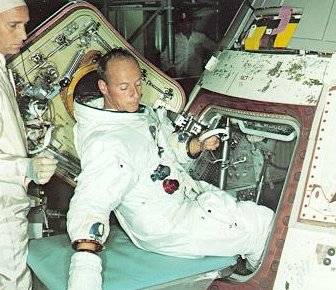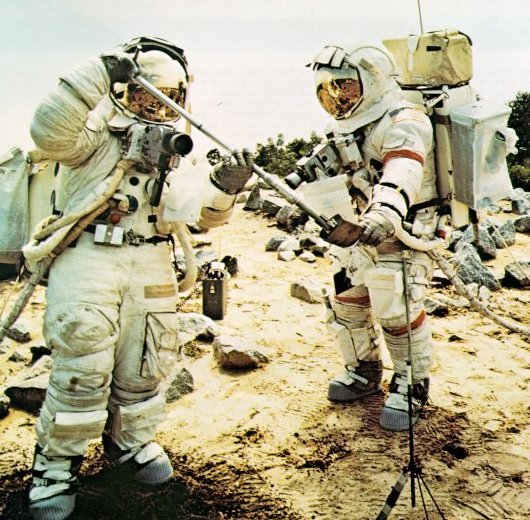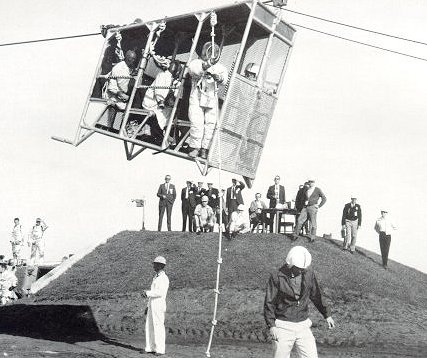Apollo Expeditions to the Moon
WHICH MEN FOR WHICH FLIGHT CREWS?
How did Deke select the men to fly? Mostly by seniority. An astronaut stood in
line until his turn came, though the order of assignment within his own group was
important. "They are a durn good bunch of guys, real fine troops, a bunch of
chargers", said Slayton in 1972. "It's not the kind of organization where you have to
keep pointing people in the right direction and kicking them to get them to go. Everybody
would like to fly every mission, but that's impossible, of course. They all understand
that, even if it makes some of them unhappy." Slayton was rarely accused of
unfairness, a remarkable achievement considering the stakes involved; his own eventual
assignment at age 48 to the Apollo-Soyuz mission was universally popular.
| | |
On mock lunar terrain, wearing restrictive pressure
suits, Schmitt and Cernan practiced collecting
geological samples. They were drilled in formal
sampling procedure: locate, radio description of size
and color, photograph in place by the gnomon,
and then collect in numbered plastic bags.
|
| | |
Fitted with Earth wheels and performance characteristics
to match those expected on the Moon, a version
of the Moon buggy was driven on rough terrain
until its handling traits were second nature to the
astronauts. They learned its steering feel, braking
ability, and grew familiar with its guidance and navigation
calculator. Here Astronauts Scott and Irwin
practice for Apollo 15.
|
Not all astronauts were equal, of course. Before the first manned Apollo flights
six crews had been formed, commanded by Schirra, Borman, McDivitt, Stafford,
Armstrong, and Conrad, who had shaken down as the natural leaders with appropriate
seniority. Before he flew Apollo 7 Schirra announced he was quitting afterward, and
that left five. Which one would land first on the Moon? It depended on the luck of
the draw. "All the crews were essentially equal", said Slayton, "and we had confidence
that any one of them could have done that first job."
Either Borman or McDivitt seemed likeliest to be first on the Moon; after they
flew their early Gemini missions they were sent straight to Apollo instead of being
recycled into later Gemini flights. But in 1968 two things happened to derail this
prospect: McDivitt, scheduled to lift off on the first Saturn V (Apollo 8), declined the
opportunity because it would not carry the LM, on which he had practiced so long.
Borman, scheduled for Apollo 9, was "highly enthusiastic" about Apollo 8, LM or no
LM, but in deference to wife and children he decided that this would be his last flight.
| | |
It's a long way down. The astronauts had to
train for the possibility that during countdown
their launch vehicle could turn into a bomb. The
rig shown here was practice for a ride for life
from the 320 ft level of the Mobile Launcher.
The astronauts would, if necessary, enter the cab
and zoom down the guide wire into an underground,
padded and insulated room, safe from
explosion. Astronaut Roosa prepares to climb
down.
|

|
Getting in and out of the hatch: a necessary
element in training. Before launch, an astronaut
had to fit into a very cramped space without
rearranging preset console switches. During return
from the Moon, it was also necessary for
one man to get out and return through the CM
hatch to retrieve the film and data cassettes from
the service module.
|
Borman's back-up was Armstrong; McDivitt's was Conrad. In each case, the
back-up shifted with the prime, so Armstrong in the normal rotation became
Apollo 11, and Conrad lost his chance to be first man on the Moon by becoming
Apollo 12. There was also the possibility that Apollo 10 (Stafford) might be the first
Moon lander - George Mueller initially saw no point in going to the Moon a second
time without touching down. But for this one the LM wasn't completely adapted for
the task (it weighed too much) and the program management decided they were not
ready for the big step. When the batting order was aligned in the summer of 1968,
nobody could have forecast how the assignments would sort out.
|




